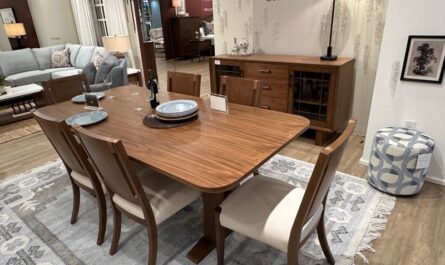In a brief cabinet talk earlier this week, Trump again reiterates promises to return furniture manufacturing jobs to North Carolina, other former manufacturing hubs
WASHINGTON — President Trump’s magical vision in which wood furniture production jobs return to North Carolina from overseas on any major scale is akin to a wish that shoe, sock or apparel manufacturing — industries that also have shifted overseas — return to the United States.
It’s also based on a totally misguided belief that these factories of the future he’s talking about will be operated by people as opposed to complex computer, AI or robotized wood shaping, assembly or finishing, not to mention 3D printing.
But in what sounded like a campaign speech during a cabinet meeting this week, Trump appeared convinced that North Carolina furniture manufacturing jobs will return by placing tariffs on imported furniture. The president made the same promise in announcing the investigation on imported furniture on his Truth Social platform this past Friday.
During the meeting, Trump said that if he were in charge, none of this shift of furniture jobs overseas would have happened as he would have placed tariffs on Chinese product upwards of 100% to 200%.
“I would have tariffed them, and China wouldn’t have taken away any of the jobs,” he said during the meeting. “But we had presidents — and honestly I like some of them, but they didn’t know what the hell they were doing from a business standpoint.”
Noting how he actually watched craftsmen and women at work, he recalled asking them to “fancy up” a rail on a chair, for example.
“They were like artists, they were like unbelievable,” he said, perhaps his most accurate statement during the meeting, followed by, “And that business was stolen from us. And by others, not only China. All of a sudden you were ordering furniture from China, and it was not even close to being as good.”
Actually these countries didn’t steal the business. The industry willfully shifted it overseas to allow consumers to get more for their dollar. More on that in a moment.
Hinting at the furniture tariffs to come once the investigation is completed, he said that his triple-digit tariffs strategy would have stemmed the massive job losses the domestic furniture industry saw during the ’90s and early 2000s.
“But we are going to rebuild North Carolina furniture and in other places — South Carolina, too, to a lesser extent — they make furniture, too,” he added. “Furniture we will put a very substantial tariff on. We have already announced it and it will be done pretty quickly. And when that happens, North Carolina can go out and start getting the grandchildren and the children and start teaching them because some of those incredible artists I knew as young people they are older people now. But they still have the talent and they have time left. But they are going to be teaching their sons and their daughters and their grandchildren. And it is going to be a beautiful thing to see. It is going to happen like magic. Without question. It is not like ‘gee, I hope it happens.’ It is going to happen.”
While all this sounds good as a campaign speech, there are certain things to understand about the industry and why so much of the industry has shifted to imports.
For one, furniture has always followed the lowest-cost labor, starting in New York and New England in the 17th century before shifting to Grand Rapids starting around the 1840s. It later shifted to North Carolina in the later 1800s and early 20th century as Michigan furniture executives on hunting trips saw the availability of even lower-cost labor than up north.
This presence in places like North Carolina and Virginia lasted a good 100 years or so before the industry began shifting sourcing to Asia in the 1990s. The shift picked up steam in the early 2000s, when North Carolina and other states lost thousands of manufacturing jobs with the rise of Chinese furniture plants that dwarfed many of their U.S. counterparts both in size and number of workers. Again, extremely skilled artisans in their own right, they worked for a fraction of the cost of labor in the U.S. And as labor is one of the highest costs of running a business alongside materials, that differential created a dynamic albeit heartbreaking loss of domestic jobs in the industry.
The shift was driven largely by competition among retailers seeking to provide their customers with the most value-driven and low-cost product and styles in their respective markets.
For some, that would include the type of carving that Trump is talking about. For others, it could be the use of fancy-face veneers, or mixed-media elements such as metal, marble, glass, stone, mirror and even fabric.
Some of the furniture featuring these materials is still being made in the U.S. But more often than not, it’s at the luxury price points that most average Americans can’t afford.
Such looks available at much lower price points are more commonly seen on imported product sourced by companies such as Ashley, Coaster, New Classic, Homelegance, Lifestyle Enterprise, Steve Silver, Crown Mark and New Classic, to name several. Even higher-end companies such as Theodore Alexander, Maitland-Smith, Sarreid Ltd. and Century import these types of products to hit a particular price point for their own respective customer base.
To produce those products in the U.S. would increase the price of product dramatically unless the factories were further subsidized by the U.S. government beyond tariffs. Without such subsidies, it’s highly unlikely that most banks would finance a manufacturing operation in the U.S., knowing full well the history of the industry to chase low-cost labor in other countries.
And while tariffs that end up being in place over the long term could help level the playing field for domestic manufacturers, it’s unknown how much more cost competitive they would be. Perhaps we will find that out in 50 days or less, or just in time for the October High Point Market.
Another hurdle for the industry would be to secure permits for both finishing and emissions, something that could be achieved with a dismantling of the EPA. But environmental regulations do not appear to be diminishing at least in the short term, particularly if you consider any number of new rules, from new sustainable packaging rules to formaldehyde emissions for upholstery and mattresses. There are also regulatory hurdles and safeguards in place by OSHA and worker’s comp that could also increase the cost of manufacturing beyond what the market would bear.
These are just several of the things that have made imports such a compelling strategy for the industry and a great value for consumers, allowing higher-end looks to be available at prices people can actually afford.
Perhaps the biggest hurdle? Getting young people back into the industry. Many are old enough to remember the devastation that plant closures had on their parents and grandparents. Not wanting to be faced with a similar fate, many have moved on to other fields less prone to competition from the global marketplace. They also are learning to adapt to a world dominated by AI and other new technologies. For some, case goods manufacturing might seem to be a thing of the past that has faded further and further from view as a sustainable career path. The same could be said of sock, shoe and apparel manufacturing. Plus, this new generation also is smarter than Trump gives them credit for: They realize that these types of manufacturing jobs one day likely will be replaced by automation and robotics as companies seek to lower health care costs and worker’s compensation claims.
Of course, none of this is to say that that there aren’t pockets of successful wood manufacturing operations left in the U.S. Vaughan-Bassett, Ashley, Sauder, Gat Creek, Chaddock, Copeland Furniture, Bassett Furniture, Stickley, Fusion Designs, Simply Amish, Daniel’s Amish, Mavin and Country View Woodworking are among the ones that come to mind among the sea of imports that have come to dominate the industry. The industry and consumers are certainly fortunate they have been so successful over their many years of operations.
Would it be worthwhile to see some new jobs created in wood furniture manufacturing because of tariffs? Yes, but we also have to be realistic given that most people have moved on from careers in furniture manufacturing given the amount of time the industry has been importing furniture from Asia and other parts of the world.
To say that these jobs are going to come back “like magic” is akin to believing fool’s gold is the real thing.
“These are all good intentions,” one industry observer told Home News Now. “It’s just 25 years too late.”





Great article Tom Russell!!
Assuming Trump has his way, no foreign country will want to do business with America anymore. If that’s the case, yes what’s left of the furniture industry would set up shop here. That however would takes years. If Trump declares himself president for life, which he’s trying to do, he would need to change labor laws, environmental laws and so much more to make it profitable for manufacturers to stay here. With AI and robots taking control the work force for manufacturing wouldn’t even be needed.
Good points all around, Tommy! Thanks for your loyal readership and support!
Do you have any information regarding what this may mean for upholstered furniture manufacturers in the US?
Hi Steve,
Thanks for reaching out, Steve. It will largely depend on which products face tariffs. The investigation currently taking place is a Section 232 investigation that deals with imports of lumber and timber as well as lumber and timber derivatives, including finished furniture. Whether that impacts imported upholstery frames remains to be seen. At this point, the only tariffs impacting either category – upholstery or wood furniture are the country specific tariffs. We will see what the administration has in store for case goods and upholstery under the 232 investigation. As always, we will do our best to keep on top of this volatile issue.
Well, when we were helping the old Eastern European countries reindustrialize, they were looking at the same problem we are thinking about we will have to bring the furniture industry back here.
Poland is a good example, they became a furniture powerhouse in Europe and are selling here.
High Point NC has become the national furniture showrooms for China, India, Vietnam, Indonesia.
An American producer has to fight no financial institutions helping manufacturing in the usa, no support network for sales, the big gus do not want to buy from a small American factory, they want containers from the big overseas factories, not start-up American factories. The only problem is the top 100 retail stores will be hurt they will have to compete with small furniture people without the hundreds of containers flooding us every day. So why not give small companies a chance to compete in North Carolina there were hundreds of small producers they will come back so fast if you give them a chance. the other thing we need to stop is private equity from buying into a good company ripping it apart and putting it out of business it is known in the industry after private equity the factory is gone in 5 years. so there is a lot to consider but after 40 years in this business it is time to help america manufacturing and quit worrying about he short term profits of a wall street bunch talling us it cannot be done.